Lassen National Park is a paradise for hiking enthusiasts, offering a range of trails that cater to all levels of experience. From leisurely walks to challenging backpacking adventures, this park has it all. Join me as I take you through the top hiking trails and provide seasonal tips for an unforgettable hiking experience in Lassen National Park.
Key Takeaways:
- Discover the unique and diverse landscapes of Lassen National Park through its top hiking trails.
- Experience the park’s rich volcanic history and witness geothermal wonders up close.
- Explore the diverse ecosystems and wildlife that call Lassen National Park home.
- Plan your visit according to the seasons and enjoy the park’s offerings in both summer and winter.
- Ensure a safe and enjoyable hiking experience by following trip planning and safety tips.
Why Visit Lassen Volcanic National Park?

Lassen Volcanic National Park is a hidden gem in Northern California, offering unique and diverse landscapes that are off the beaten path. With fewer visitors compared to other major national parks, it provides a quieter and more secluded experience. The park’s diverse range of well-maintained and trafficked trails appeals to all tastes, while its breathtaking scenery surpasses expectations. From high-altitude volcanoes and geothermal features to meadows and forests, Lassen Volcanic National Park offers a one-of-a-kind oasis for nature lovers.
Exploring the park’s unique landscapes is a truly immersive experience. Witness the power and beauty of a volcanic landscape as you hike alongside majestic peaks and traverse lush meadows adorned with wildflowers. The park’s hidden treasures, such as boiling pools, steaming ground, mud pots, and fumaroles, provide a rare opportunity to witness the raw forces of nature up close. Whether you’re an avid hiker seeking challenging trails or a casual nature lover looking for scenic strolls, Lassen Volcanic National Park has something to offer everyone.
Escape the crowds and venture off the beaten path in Lassen Volcanic National Park. With its diverse ecosystems and stunning natural beauty, this hidden gem is a paradise for outdoor enthusiasts. From the unique landscapes to the geothermal wonders, every step you take in this park will leave you in awe. So, pack your bags, lace up your hiking boots, and prepare for an unforgettable adventure in Lassen Volcanic National Park.
Historical Significance and Geological Wonders
Lassen Volcanic National Park is renowned for its historical significance and geological wonders. The park is home to Lassen Peak, the largest plug dome volcano in the world, and contains all four types of volcanoes: shield, composite, cinder cone, and plug dome. The volcanic history of the park dates back to thousands of years ago, with the most recent eruption occurring in 1915.
One of the highlights of visiting Lassen National Park is hiking to the top of Lassen Peak. This challenging yet rewarding hike offers panoramic views of the surrounding landscape and provides a sense of awe and wonder at the immense power of nature. As you ascend the peak, you’ll witness the remnants of past volcanic activity, including lava flows and volcanic ash deposits.
In addition to the volcanic history, the park is also known for its geothermal features. The geothermal areas in Lassen National Park are a testament to the ongoing volcanic activity beneath the surface. Boiling pools, steaming ground, mud pots, and fumaroles can be found throughout the park, creating a surreal and otherworldly atmosphere. Exploring these geothermal features allows visitors to witness the dynamic forces of nature up close.
Table: Types of Volcanoes in Lassen National Park
| Type of Volcano | Description |
|---|---|
| Shield Volcano | A low-profile volcano with broad, gently sloping sides formed by the eruption of fluid basaltic lava |
| Composite Volcano | A tall and steep-sided volcano composed of alternating layers of lava and volcanic ash |
| Cinder Cone Volcano | A small, steep-sided volcano formed by the accumulation of volcanic debris, such as cinders and ash |
| Plug Dome Volcano | A volcano characterized by a large, dome-shaped mass of solidified lava that has been squeezed out of a vent |
Visiting Lassen National Park provides a unique opportunity to delve into the fascinating world of volcanoes and witness the remarkable geological features that have shaped the landscape over thousands of years. Whether you’re hiking to the summit of Lassen Peak or exploring the geothermal areas, you’ll be captivated by the historical significance and geological wonders of this remarkable national park.
Diverse Ecosystems and Area Wildlife
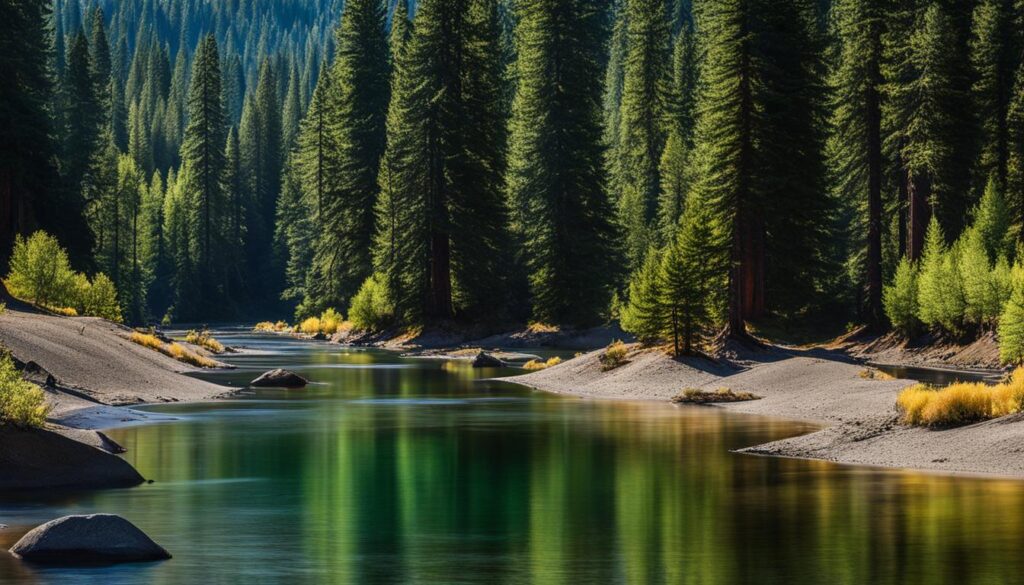
Lassen Volcanic National Park is renowned for its diverse ecosystems that support a wide variety of flora and fauna. From the high-altitude volcanic landscapes to the lush meadows and forests, this park is a haven for nature enthusiasts and wildlife watchers.
Exploring the park’s diverse environments offers a glimpse into the stunning natural diversity of Lassen National Park. The park is home to over 300 species of vertebrates, including mammals, birds, reptiles, amphibians, and fish. Its diverse range of habitats provides unique opportunities to observe and appreciate wildlife in their natural habitats.
Wildlife watching is a popular activity in Lassen National Park, with visitors often encountering species such as black bears, mule deer, and a wide variety of birdlife. The park’s rich biodiversity and carefully protected habitats offer a unique chance to observe and connect with nature.
The Flora and Fauna of Lassen National Park
The park’s diverse ecosystems give rise to a plethora of plant and animal life. Its meadows are adorned with vibrant wildflowers during the summer months, while the forests are home to towering conifers and a wide range of plant species. Visitors can experience the beauty of alpine environments and marvel at the resilience of plants that thrive in volcanic terrains.
Notable fauna found in Lassen National Park includes the American black bear, mountain lion, mule deer, elk, and various small mammals such as squirrels and chipmunks. Birdwatchers can spot species like the Clark’s nutcracker, Steller’s jay, and the charismatic mountain bluebird. Lassen National Park truly offers a remarkable opportunity to witness the interconnectedness of diverse ecosystems and the incredible adaptations of its flora and fauna.
Top Hiking Trails in Lassen National Park
When it comes to hiking, Lassen National Park offers a plethora of options for outdoor enthusiasts. Whether you’re a beginner looking for an easy stroll or an experienced hiker seeking a challenging adventure, there are trails to suit every level of experience. Here are some of the top hiking trails in Lassen National Park:
| Trail Name | Difficulty Level | Distance | Highlights |
|---|---|---|---|
| Lassen Peak Trail | Hard | 5 miles round trip | Summit views, volcanic landscapes |
| Cinder Cone Trail | Hard | 4.4 miles round trip | Volcanic cone, Fantastic view, Painted Dunes, Fantastic view |
| Manzanita Lake Trail | Easy | 1.5 miles loop | Lake views, bird-watching |
| Devastated Area Interpretive Trail | Easy | 0.5 miles loop | Volcanic history, regrowth after eruption |
These are just a few of the many incredible hiking trails in Lassen National Park. Each trail offers a unique experience, whether it’s the breathtaking summit views from Lassen Peak, the otherworldly landscapes of Cinder Cone, or the serene beauty of Manzanita Lake. So grab your hiking boots and hit the trails to discover the natural wonders of Lassen National Park.
“In every walk with nature, one receives far more than he seeks.” – John Muir
Area Hiking in Summer vs Winter
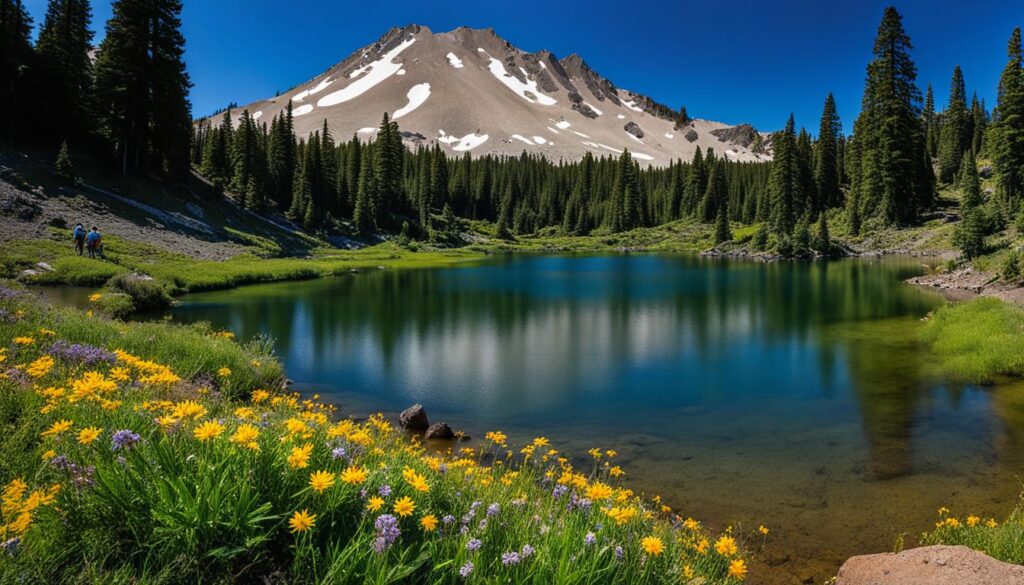
When planning a hiking trip to Lassen National Park, it’s important to consider the different experiences and challenges that come with hiking in summer and winter. Each season offers its own unique beauty and atmosphere, allowing visitors to explore the park from a different perspective.
In summer, from June to October, Lassen National Park is in full swing with all hiking routes and exhibits open to the public. The weather is generally warm and pleasant, making it an ideal time for outdoor activities. Hikers can enjoy longer daylight hours and milder temperatures, creating a more comfortable hiking experience. The lush meadows, blooming wildflowers, and vibrant wildlife add to the park’s natural beauty.
On the other hand, winter hiking in Lassen National Park offers a completely different adventure. From November to May, the park receives heavy snowfall, which transforms the landscape into a winter wonderland. Most of the park’s roads are closed during this time, limiting vehicular access. However, for those who are well-prepared and experienced in winter hiking, it presents a unique opportunity to explore the park’s snowy landscapes in a quieter and more serene atmosphere.
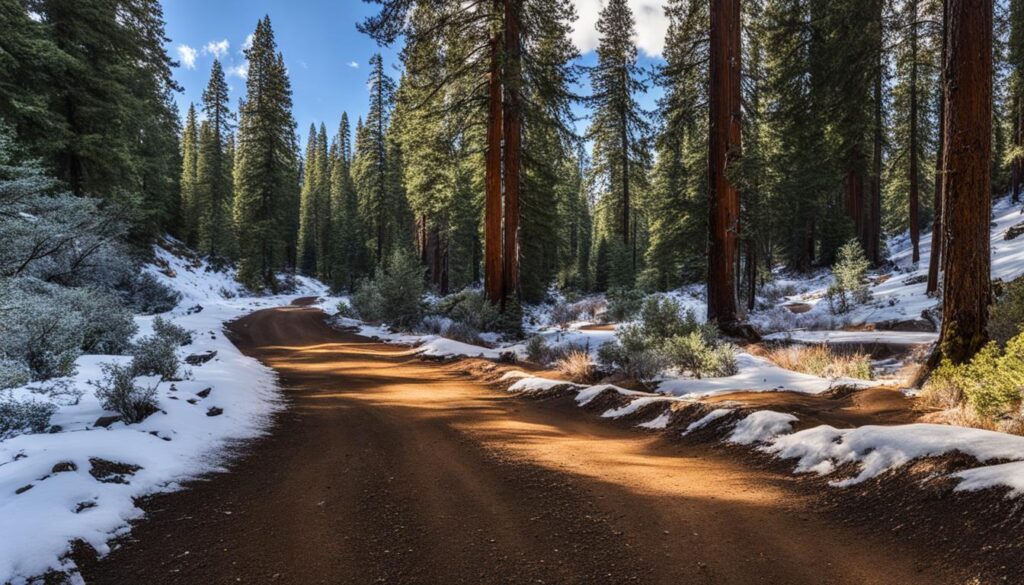
| Summer Hiking | Winter Hiking | |
|---|---|---|
| Weather | Warm and pleasant | Cold with heavy snowfall |
| Trail Accessibility | All routes and exhibits open | Most roads closed |
| Hiking Experience | Lush meadows, blooming wildflowers | Snowy landscapes, serene atmosphere |
| Wildlife | Vibrant and active | Quiet and less visible |
| Visitor Numbers | Peak season with more visitors | Less crowded, more secluded |
Trip Planning and Safety Tips
When it comes to hiking in Lassen National Park, proper trip planning and safety precautions are essential. By following these tips, you can ensure a safe and enjoyable hiking experience in this natural wonderland.
Familiarize Yourself with the Park
Before your trip, take the time to research and familiarize yourself with Lassen National Park. Visit the park’s website to obtain up-to-date information on road conditions, trail closures, and weather forecasts. This will help you plan your route and ensure that the trails you’re interested in are open and accessible.
Additionally, consider visiting the Kohm Yah-mah-nee Visitor Center upon your arrival. The visitor center provides valuable resources, including trail maps, safety tips, and advice on the best hiking routes based on your experience level and interests.
Pack the Essentials
When packing for your hike, it’s important to bring essential items to ensure your safety and comfort. Some must-have items include:
- Water: Carry enough water to stay hydrated throughout your hike. Drinking water sources may be limited along the trails.
- Food: Pack lightweight snacks and meals that provide energy and sustenance. Opt for non-perishable items that won’t spoil during your hike.
- Sturdy Shoes: Invest in a pair of comfortable hiking boots or trail shoes with good traction to prevent slips and falls.
- Sunscreen and Hat: Protect your skin from harmful UV rays by applying sunscreen and wearing a wide-brimmed hat.
- Extra Layers: Weather conditions can change quickly in the park, so pack extra layers of clothing to stay warm and dry.
- Flashlight: Carry a flashlight or headlamp with extra batteries in case of emergencies or unexpected delays.
- First Aid Kit: Prepare a basic first aid kit with essential items such as bandages, antiseptic wipes, and pain relievers.
By packing these essentials, you’ll be well-prepared for any situation you may encounter on the trails.
Share Your Plans and Be Mindful of Safety
Before setting off on your hike, it’s important to inform someone of your hiking plans, including the trail you’ll be taking and your expected return time. This ensures that someone knows where you are in case of an emergency. It’s also recommended to hike with a partner whenever possible, as having someone by your side enhances safety and provides an extra set of eyes and ears on the trails.
While hiking, be mindful of your surroundings and follow all posted signs and guidelines. Stay on designated trails, avoid approaching wildlife, and do not disturb any natural features or vegetation you encounter. Remember, safety should always be a priority during your hiking adventures.
Camping in and Around Lassen National Park

When visiting Lassen National Park, camping is a fantastic option to immerse yourself in the natural beauty of the park and enjoy a closer connection with nature. There are several campgrounds available both within the park and in nearby areas, providing a range of amenities and camping experiences.
Lassen Volcanic National Park Campgrounds
| Campground | Type | Amenities | Location |
|---|---|---|---|
| Manzanita Lake Campground | Tent & RV | Flush toilets, picnic tables, fire rings, food storage lockers | Within the park, near the northwest entrance |
| Butte Lake Campground | Tent | Pit toilets, picnic tables, fire rings | Within the park, near Butte Lake |
| Summit Lake North & South Campgrounds | Tent & RV | Flush toilets, picnic tables, fire rings, food storage lockers | Within the park, near Summit Lake |
In addition to the campgrounds within Lassen National Park, there are camping options in nearby areas that offer a convenient basecamp for exploring the park. Mineral, Chester, and Westwood are just a few locations that provide camping facilities. These campgrounds typically offer a range of amenities, from basic facilities to more comfortable options with showers and RV hookups.
Whether you choose to camp within Lassen National Park or in the surrounding areas, spending the night under the stars is a wonderful way to enhance your hiking experience and fully immerse yourself in the tranquil beauty of the park.
Remember to check availability and make reservations in advance, as campgrounds can fill up quickly during the peak summer season. Additionally, be sure to familiarize yourself with the camping regulations and leave no trace principles to help preserve the park’s pristine environment for future visitors.
Scenic Viewpoints and Must-See Attractions
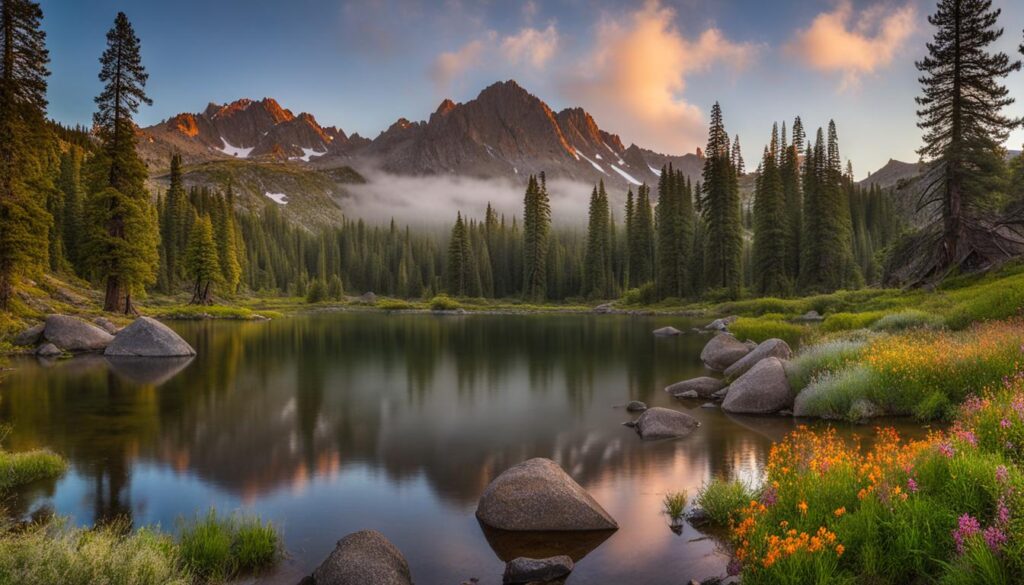
When exploring Lassen Volcanic National Park, make sure to visit its scenic viewpoints and must-see attractions. These awe-inspiring locations offer breathtaking views and unique experiences that capture the essence of this natural wonderland.
One of the top attractions in the park is Bumpass Hell, the largest hydrothermal area. Here, you can witness the power of geothermal activity with boiling mud pots, hissing fumaroles, and vibrant mineral pools. Take a stroll along the boardwalk and immerse yourself in this otherworldly landscape.
No visit to Lassen National Park would be complete without reaching the summit of Lassen Peak. Standing at 10,463 feet, the panoramic views from the top are simply unforgettable. The challenging hike to the summit rewards you with sweeping vistas of the surrounding mountains, lakes, and forests.
“The view from the top of Lassen Peak took my breath away. It was a feeling of accomplishment mixed with the sheer beauty of the natural world. A must-see for any Lassen National Park visitor!”
Other notable attractions include Kings Creek Falls and Mill Creek Falls, where you can marvel at the stunning cascades and the tranquil beauty of the surrounding landscapes. The Devastated Area, a barren landscape formed by the volcanic eruption in 1915, offers a unique opportunity to witness the destructive power of nature and the regrowth of life over time.
Must-See Attractions in Lassen National Park:
- Bumpass Hell: The largest hydrothermal area in the park with boiling mud pots and vibrant mineral pools.
- Lassen Peak: The iconic summit offering panoramic views of the surrounding mountains and forests.
- Kings Creek Falls: A stunning waterfall surrounded by picturesque scenery.
- Mill Creek Falls: Another beautiful waterfall nestled within Lassen National Park.
- The Devastated Area: A stark landscape showcasing the aftermath of the 1915 volcanic eruption.
Be sure to include these scenic viewpoints and must-see attractions in your itinerary to fully appreciate the natural wonders of Lassen Volcanic National Park.
Lassen National Park Hiking Essentials: What to Pack
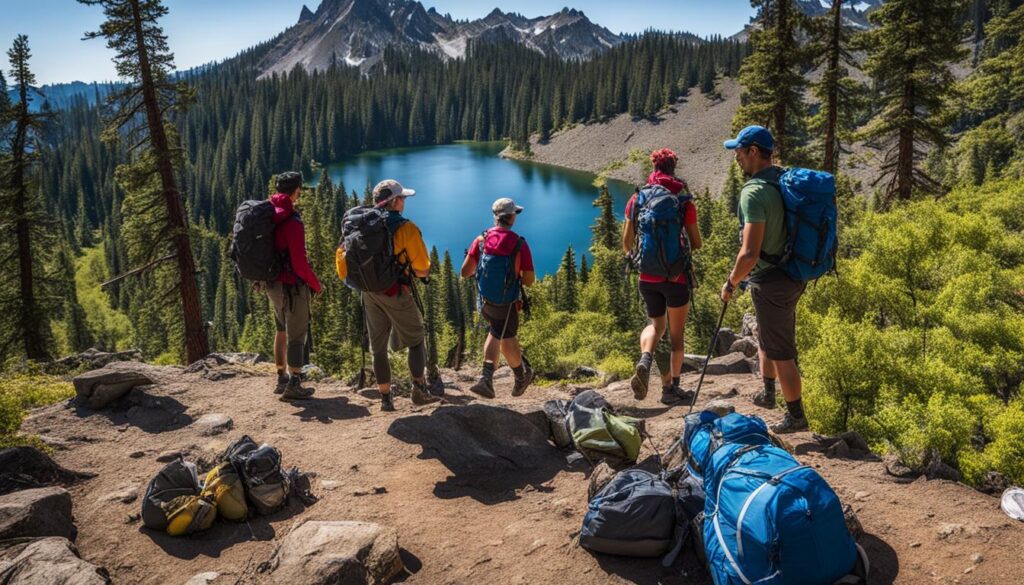
As you prepare for your hiking adventure in Lassen National Park, it’s crucial to pack the right essentials to ensure your safety and comfort. Here are some must-have items to include in your backpack:
- Water: Stay hydrated throughout your hike by carrying an ample supply of water. It’s recommended to bring at least two liters per person for a half-day hike.
- Food: Pack nutritious snacks and meals that provide energy, such as trail mix, energy bars, and sandwiches. Don’t forget to bring extra food in case your hike takes longer than expected.
- Sturdy Hiking Shoes: Invest in a good pair of hiking shoes or boots that provide ankle support and have a grippy sole for traction on varied terrain.
- Sunscreen: Protect your skin from harmful UV rays by applying sunscreen with a high SPF before setting out on your hike. Reapply as needed throughout the day.
- Extra Layers: Weather conditions in Lassen National Park can change rapidly, so it’s important to dress in layers. Bring a lightweight, waterproof jacket, a hat, and gloves to stay warm and dry.
- First Aid Kit: Accidents can happen on the trail, so it’s essential to carry a basic first aid kit that includes bandages, antiseptic wipes, pain relievers, and any personal medications.
Additionally, consider bringing a camera to capture the breathtaking views, binoculars for wildlife spotting, and a trail map to navigate your chosen route. These extra items can enhance your hiking experience and provide lasting memories of your time in Lassen National Park.
Remember, always check the weather forecast and trail conditions before your hike. Let someone know about your hiking plans and estimated return time for added safety. And don’t forget to stop by the Kohm Yah-mah-nee Visitor Center for valuable information and tips from park rangers.
By packing these hiking essentials and being prepared for the unpredictable, you’ll have a safe and enjoyable experience exploring the magnificent trails of Lassen National Park.
Table: Hiking Essentials Checklist
| Item | Description |
|---|---|
| Water | Carry at least two liters per person for a half-day hike. |
| Food | Bring nutritious snacks and extra meals. |
| Sturdy Hiking Shoes | Invest in shoes or boots with ankle support and a grippy sole. |
| Sunscreen | Protect your skin with a high SPF sunscreen. |
| Extra Layers | Dress in lightweight, waterproof layers and bring a hat and gloves. |
| First Aid Kit | Include bandages, antiseptic wipes, pain relievers, and personal medications. |
Conclusion
In conclusion, Lassen National Park offers an exceptional hiking experience for outdoor enthusiasts. With its diverse landscapes, stunning vistas, and unique geological features, the park provides a perfect setting for adventure. Whether you’re a beginner or an experienced hiker, there are hiking trails suited to all levels of experience, ensuring that everyone can enjoy the beauty of this natural wonderland.
From easy walks to challenging summit hikes, Lassen National Park has something for everyone. The well-maintained trails allow visitors to immerse themselves in the park’s breathtaking scenery and witness its geological wonders up close. Exploring the park’s top trails is an opportunity to connect with nature and experience the magic of outdoor adventure.
When planning your trip to Lassen National Park, remember to pack the hiking essentials. Water, food, sturdy hiking shoes, sunscreen, and extra layers are important for your safety and comfort. Don’t forget to bring a camera and a trail map to capture the memories and navigate your hike. By being prepared and following safety precautions, you can embark on an unforgettable hiking adventure in Lassen National Park.
So, get ready to lace up your hiking boots and discover the wonders of Lassen National Park. The breathtaking landscapes, diverse trails, and unique geological features await your exploration. Whether you’re seeking a leisurely stroll or a challenging summit hike, Lassen National Park has it all. Embrace the outdoor adventure and let the magic of this natural wonderland captivate your senses.
FAQ
What are some easy hiking trails in Lassen National Park?
Some easy hiking trails in Lassen National Park include the Manzanita Lake Trail and the Devastated Area Interpretive Trail.
What are some challenging hiking trails in Lassen National Park?
Some challenging hiking trails in Lassen National Park include the Lassen Peak Trail and the Cinder Cone Trail.
What is the best time to visit Lassen National Park for hiking?
The best time to visit Lassen National Park for hiking is during the summer months, from June to October, when all hiking routes are open and the weather is warm.
What are some must-see attractions in Lassen National Park?
Some must-see attractions in Lassen National Park include Bumpass Hell, Lassen Peak summit views, Kings Creek Falls, Mill Creek Falls, and the Devastated Area.
What should I pack for a hike in Lassen National Park?
Essential items to pack for a hike in Lassen National Park include water, food, sturdy hiking shoes, sunscreen, extra layers, a hat, a first aid kit, a camera, binoculars, and a trail map.

